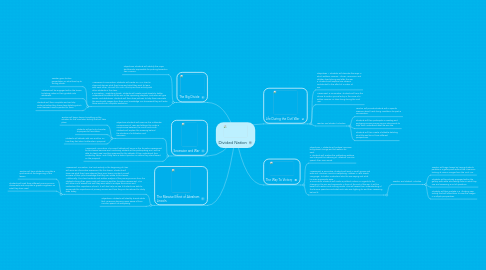
1. The Big Divide
1.1. Objectives: Students will identify the major abolitionists responsible for pushing towards a free America.
1.2. Assessment: • Formative: Students will create a K-W-L chart in class and discuss what they know and what they want to learn with each other. This will turn into a think-pair-share activity with other students in the class. • Formative: Vocabulary sheets. Students will create vocab sheets to better understand the effects of the war in the upcoming chapters. Instructor will give words, and definitions. Students will then draw pictures to help them associate the words with images from their prior knowledge. For homework they will write these words into complete sentences.
1.2.1. Teacher gives lecture presentation on what lead up to the big divide.
1.2.2. Students will be engaged within the lesson by taking notes on their guided note worksheet.
1.2.3. Students will then complete and exit slip write-up before they leave class detailing which event seemed most important to them.
2. Life During the Civil War
2.1. Objectives 1. Students will describe the ways in which soldiers, women, African Americans, and children lived during and after the war. 2. Students will explore how citizens contributed to the effort of a nation at war.
2.2. Assessment: • Summative: Students will have the choice to write a journal entry in the voice of a soldier, woman, or slave living during the Civil War.
2.3. Teacher and Student Activities
2.3.1. Teacher will provide students with a specific scenario about harsh living conditions to spark a conversation.
2.3.2. Students will then participate in reading and analyzing various primary source documents to help them understand what life was like.
2.3.3. Students will then create a foldable detailing what life was like in three different perspectives.
3. Secession and War
3.1. Objectives Students will examine the Crittenden Compromise of 1860 and attempt to create a compromise between the North and South. Students will explain the meaning behind the doctrine of nullification and secession.
3.1.1. Teacher will begin lesson by setting up the situation for the simulation activity that will take place.
3.1.2. Students will get into character to prepare for simulation.
3.1.3. Students will debate with one another on how they feel about Crittenden's proposal.
3.2. Assessment: Formative: The overall debate will serve as the formative assessment for this lesson because each and every student will be participating and I will be able to clearly see how they prepared for the debate, if they understood their vocabulary terms, and if they have a distinct position on where they stand based on the proposal.
4. The Massive Effect of Abraham Lincoln.
4.1. Assessment: Formative: The hook activity in the beginning of class will serve as a formative assessment for this lesson. Students will show me what they have retained from prior lesson content, as well as areas of their prior knowledge that they can relate to this lesson. Additionally, the class handouts and written analysis of the primary sources from the students during their group work will serve as another formative assessment. This will allow me to assess how well they were able to analyze the sources and understand the importance of each. It will also help me see if students are able to appreciate the importance of primary sources and how they can be relevant to study even today.
4.1.1. Teacher will have students complete a quick-write at the beginning of the lesson.
4.1.2. Students will read three different primary source documents and complete a graphic organizer on what they have read.
4.2. Objectives: Students will identify shared ideals that Americans became more aware of from Lincoln’s speech at Gettysburg.
5. The Way To Victory
5.1. Objectives 1. Students will analyze how wars bring about change and list reasons for each. 2. Students will analyze the Gettysburg address and interpret the meaning of Abraham Lincoln’s speech their own words.
5.2. Assessment: • Formative: Students will work in small groups and write out Abraham Lincoln’s Gettysburg Address in “8th Grade Language” to better understand what he was saying and what his main arguments were. • Summative: Students will create a political cartoon in regards to the changes in the war and arguments in favor of the end of the war. It will be based off a Rubric and Scoring Guide. This will assess their understanding of the famous speeches and what each side was fighting for and their reasoning behind it.
5.2.1. Teacher and Student Activities
5.2.1.1. Teacher will begin lesson by having students partake in a gallery walk around the classroom looking at various images from the Civil War.
5.2.1.2. Students will be actively engaged within the gallery walk while also taking note on what they see and answering a set of questions.
5.2.1.3. Students will then partake in a "thinking cap" activity that will allow them to view the images in multiple perspectives.
